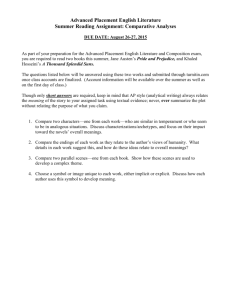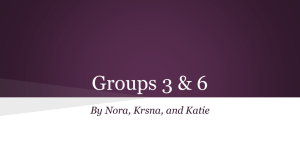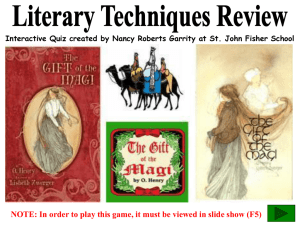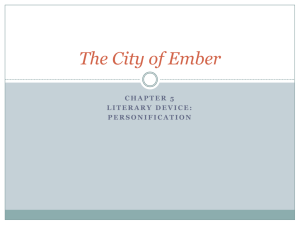Style Terms Handout
advertisement
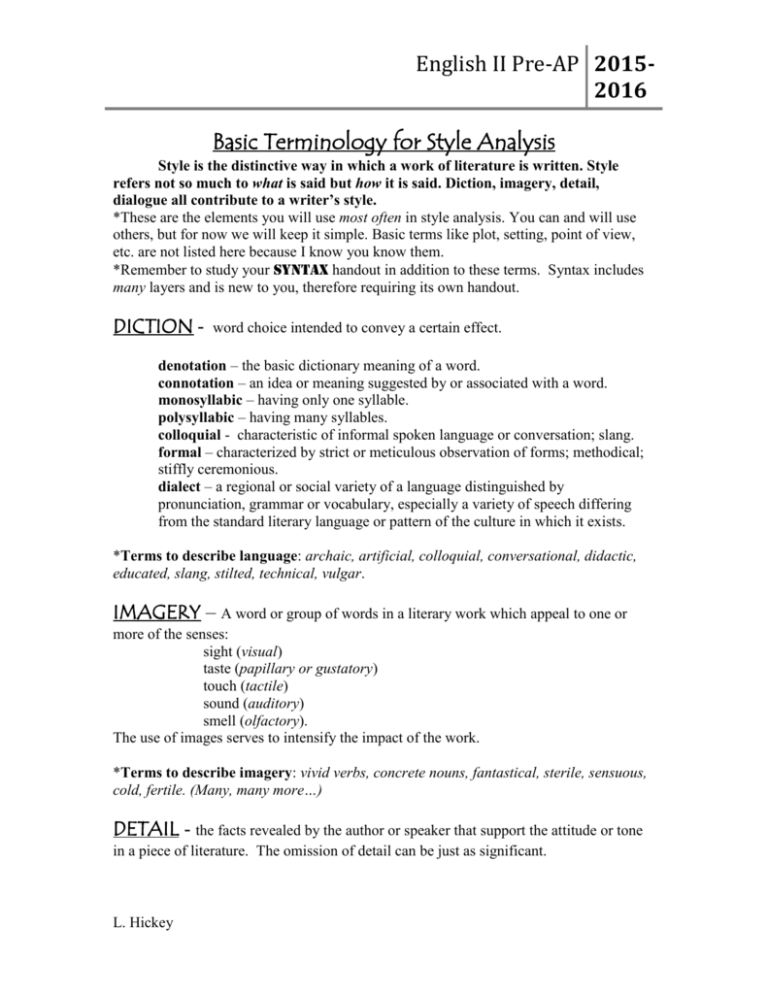
English II Pre-AP 20152016 Basic Terminology for Style Analysis Style is the distinctive way in which a work of literature is written. Style refers not so much to what is said but how it is said. Diction, imagery, detail, dialogue all contribute to a writer’s style. *These are the elements you will use most often in style analysis. You can and will use others, but for now we will keep it simple. Basic terms like plot, setting, point of view, etc. are not listed here because I know you know them. *Remember to study your SYNTAX handout in addition to these terms. Syntax includes many layers and is new to you, therefore requiring its own handout. DICTION - word choice intended to convey a certain effect. denotation – the basic dictionary meaning of a word. connotation – an idea or meaning suggested by or associated with a word. monosyllabic – having only one syllable. polysyllabic – having many syllables. colloquial - characteristic of informal spoken language or conversation; slang. formal – characterized by strict or meticulous observation of forms; methodical; stiffly ceremonious. dialect – a regional or social variety of a language distinguished by pronunciation, grammar or vocabulary, especially a variety of speech differing from the standard literary language or pattern of the culture in which it exists. *Terms to describe language: archaic, artificial, colloquial, conversational, didactic, educated, slang, stilted, technical, vulgar. IMAGERY – A word or group of words in a literary work which appeal to one or more of the senses: sight (visual) taste (papillary or gustatory) touch (tactile) sound (auditory) smell (olfactory). The use of images serves to intensify the impact of the work. *Terms to describe imagery: vivid verbs, concrete nouns, fantastical, sterile, sensuous, cold, fertile. (Many, many more…) DETAIL - the facts revealed by the author or speaker that support the attitude or tone in a piece of literature. The omission of detail can be just as significant. L. Hickey English II Pre-AP 20152016 LANGUAGE –Describes the combination of words used in a text which includes concrete and abstract elements. Concrete – Language that describes qualities that can be perceived with the senses or that can be precisely located in a piece of literature. Abstract – Language that describes qualities that cannot be perceived with the five senses. For instance, calling something pleasant or pleasing is abstract, while calling something yellow or sour is concrete. Figures of speech/Figurative language – (sometimes termed a rhetorical device) writing or speech that is not meant to be interpreted literally ( Ex: simile, metaphor, personification, etc.) This technique adds color or meaning: often deeper and more complex than literal meaning of words. apostrophe – a form of personification in which the absent, dead, or inanimate are spoken to as if present or animate. Ex: from Shakespeare’s Julius Caesar For Antony. O judgment, thou art fled to brutish beasts, Comparisions: And men have lost their reason! (III, ii, 106 – 107) Simile, metaphor, hyperbole – a deliberate exaggeration or overstatement. symbol, allusion metaphor - a comparison in which one thing is spoken of as though it were something else. For Emphasis: metonymy - a figure of speech in which a word represents something else Hyperbole, which it suggests. For example in a herd of fifty cows, the herd might be understatement referred to as fifty head of cattle. The word "head" is the word For Illusion or representing the herd. Fantasy: motif – a repeated word, image, object, action, or situation that helps to unify a literary work. Personification, oxymoron – a form of paradox that combines two opposing ideas (Ex. apostrophe, Jumbo shrimp). symbolism paradox – a statement that seems self-contradictory or absurd but that expresses a truth. personification – use of language that gives non-human objects or ideas human qualities. pun – a play on words that are identical or similar in sound but have sharply diverse meanings. simile – a comparison of two different things or ideas through the use of the words like or as. Sound devices – stylistic techniques that convey meaning through sound (Ex. rhyme, assonance, consonance, etc.) alliteration – the repetition of initial consonant sounds (Ex.: “Dennis the dragonfly darted down, his wings whirring”). L. Hickey English II Pre-AP 20152016 assonance – the repetition of vowel sounds in a series of words (Ex.: She wanted to eat a slice of cake, but she was late). consonance – the repetition of consonant sounds at the ends of words in a series onomatopoeia – the use of words that mimic the sounds they describe (Ex.: swish, buzz, hiss, smack). rhyme – the repetition of sounds in two or more words or phrases that appear close to each other. SYNTAX – refer to syntax handout ☺. Coming soon! TONE - the attitude a writer takes towards a subject or character; ex: serious, humorous, sarcastic, ironical, satirical, objective, etc. Remember: DIDLS (diction, imagery, detail, language and syntax) all help to create tone. IRONY – takes on many forms. In situational irony, the result of an action is the reverse of what the actor expected. In dramatic irony, the audience knows something that the characters do not. In verbal irony, the contrast is between the literal meaning of what is said and what is meant. A character may refer to a plan as brilliant, while actually meaning that (s)he thinks the plan is foolish. Sarcasm is a form of verbal irony. THEME - The central meaning or dominant idea in a literary work. A theme provides a unifying point around which the plot, characters, setting, point of view, symbols, and other elements (for example, all of the ones I’ve listed for you on this handout) of a work are organized. It is important not to mistake the theme for the actual subject of the work; the theme refers to the abstract concept that is made concrete through the images, characterization, and action of the text. In nonfiction, however, the theme generally refers to the main topic of the discourse. Author’s PURPOSE: Always remember the big picture. What is the author’s goal in writing the piece? Purpose must always be considered. To describe To inform To entertain To explain To tell a story To ridicule To persuade : ethos, logos, pathos L. Hickey English II Pre-AP 20152016 L. Hickey

